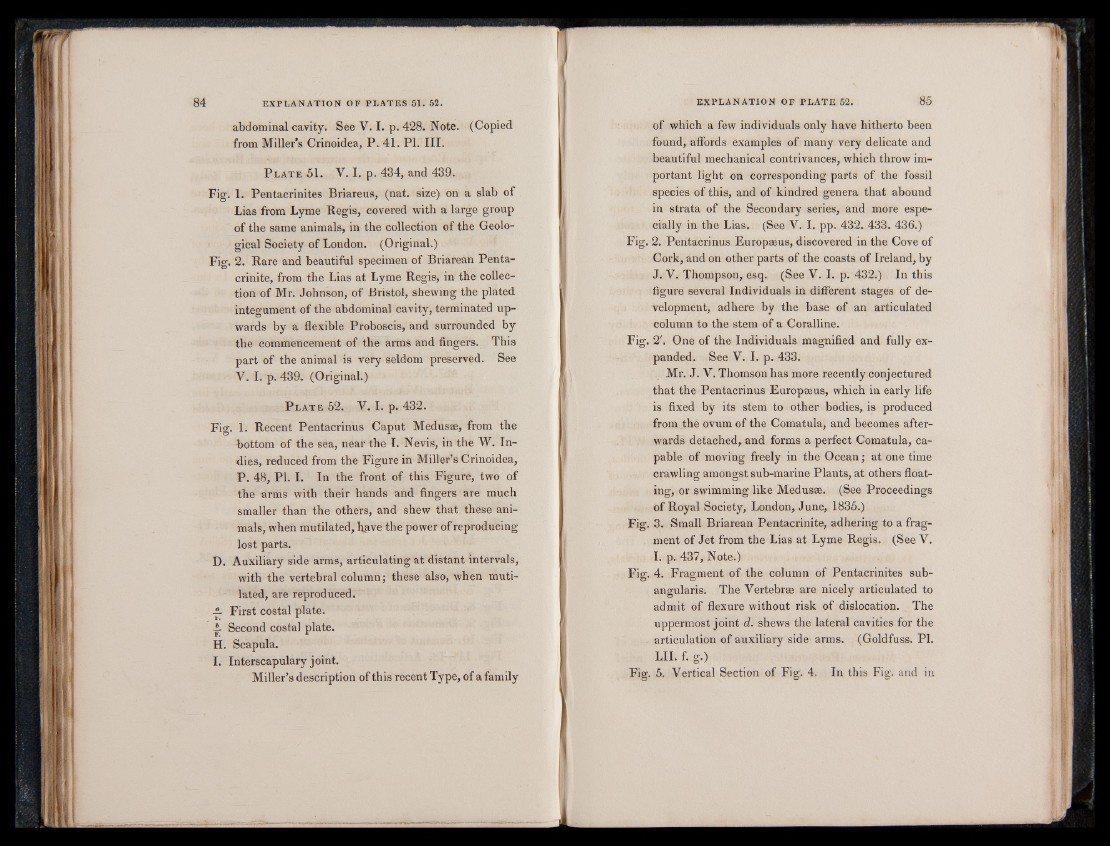
abdominal cavity. See V. I. p. 428. Note. (Copied
from Miller’s Crinoidea, P. 41. PI. III.
P late 51. V. I. p. 434, and 439.
Fig. 1. Pentacrinites Briareus, (nat. size) on a slab of
Lias from Lyme Regis, covered with a large group
of the same animals, in the collection of the Geological
Society of London. (Original.)
Fig. 2. Rare and beautiful specimen of Briarean Penta-
crinite, from the Lias at Lyme Regis, in the collection
of Mr. Johnson, of Bristol, shewing the plated
integument of the abdominal cavity, terminated upwards
by a flexible Proboscis, and surrounded by
the commencement of the arms and fingers. This
part of the animal is very seldom preserved. See
V. I. p. 439. (Original.)
P late 52. Y. I. p. 432.
Fig. 1. Recent Pentacrinus Caput Medusse, from the
bottom of the sea, near the I. Nevis, in the W. Indies,
reduced from the Figure in Miller’s Crinoidea,
P. 48, PI. I. In the front of this Figure, two of
the arms with their hands and fingers are much
smaller than the others, and shew that these animals,
when mutilated, Kave the power of reproducing
lost parts.
D. Auxiliary side arms, articulating at distant intervals,
with the vertebral column; these also, when mutilated,
are reproduced.
— First costal plate.
± Second costal plate.
H. Scapula.
I. Interscapulary joint.
Miller’s description of this recent Type, of a family
of which a few individuals only have hitherto been
found, affords examples of many very delicate and
beautiful mechanical contrivances, which throw important
light on corresponding parts of the fossil
species of this, and of kindred genera that abound
in strata of the Secondary series, and more especially
in the Lias. (See V. I. pp. 432. 433. 436.)
Fig. 2. Pentacrinus Europseus, discovered in the Cove of
Cork, and on other parts of the coasts of Ireland, by
J. V. Thompson, esq. (See V. I. p. 432.) In this
figure several Individuals in different stages of development,
adhere by the base of an articulated
column to the stem of a Coralline.
Fig. 2'. One of the Individuals magnified and fully expanded.
See V. I. p. 433.
Mr. J. V. Thomson has more recently conjectured
that the Pentacrinus Europseus, which in early life
is fixed by its stem to other bodies, is produced
from the ovum of the Comatula, and becomes afterwards
detached, and forms a perfect Comatula, capable
of moving freely in the Ocean; at one time
crawling amongst sub-marine Plants, at others floating,
or swimming like Medusse. (See Proceedings
of Royal Society, London, June, 1835.)
Fig. 3. Small Briarean Pentacrinite, adhering to a fragment
of Jet from the Lias at Lyme Regis. (See V.
I. p. 437, Note.)
Fig. 4. Fragment of the column of Pentacrinites sub-
angularis. The Vertebrse are nicely articulated to
admit of flexure without risk of dislocation. The
uppermost joint d. shews the lateral cavities for the
articulation of auxiliary side arms. (Goldfuss. PL
LII. f. g.)
Fig. 5. Vertical Section of Fig. 4. In this Fig. and in